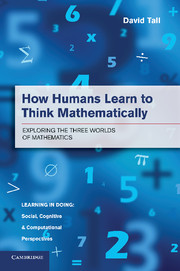Book contents
Appendix - Where It All Came From
Published online by Cambridge University Press: 05 June 2014
Summary
The ideas in this book blend together a theoretical growth over many years. Here I trace the origins of the main ideas.
The early analysis of human thought in relation to mathematics includes the fundamental ideas of Aristotle and Plato with the human perception of potential infinity and the perfect existence of Platonic thought. Descartes shifted thinking to focus on the interaction between the physical brain and the spiritual mind. In his Critique of Pure Reason Kant considered the way in which the brain contemplates the outside world and introduced the term ‘schema’ to describe the mental pattern that could delineate a general concept such as ‘dog’ as opposed to specific perceptions of individual dogs.
In the late nineteenth and early twentieth centuries two developments occurred, the first being the introduction of The Principles of Psychology by William James and the second, the publication of occasional books in which mathematicians reflected on the nature of mathematical thinking, such as Poincaré's Science and Hypothesis. In particular, Poincaré distinguished two kinds of mathematical thinking, one preoccupied by logic, advancing carefully step by step, the other guided by intuition, making quick but sometimes precarious advances. It was this that stirred my interest in the distinction between the ideas of formal and embodied ways of thinking.
- Type
- Chapter
- Information
- How Humans Learn to Think MathematicallyExploring the Three Worlds of Mathematics, pp. 421 - 432Publisher: Cambridge University PressPrint publication year: 2013

